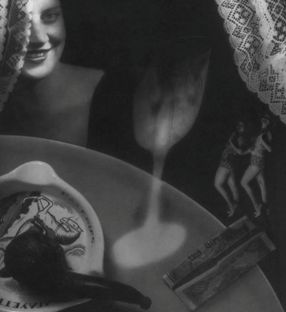When people start talking about art, chances are, they will be talking about the sophistication of Impressionism or Renaissance, or discussing for the fourth millionth time why the smile of Da Vinci’s Mona Lisa is so mysterious, if not somewhat sinister. There are slimmer chances though, that they will be talking about Surrealism. And Surrealism is something worth talking about, so let us eliminate this outrageous injustice and say a word or two about Surrealism.
As a cultural movement, Surrealism has developed in Europe in the 1920s, with its centre in Paris, and brought out such major artists like Salvador Dalí, André Breton, René Magritte. The initial idea of Surrealism was to resolve the “contradictory conditions of dream and reality”. So, basically, the movement appeared as a rebellion against the rationalism, aiming to liberate their imagination, both conscious and subconscious. At the very beginning Surrealism was hiding in small cafes and close-knit circles of friends, but at its peak, it spread around the Europe, the globe, and eventually reached Asia.
Out of all the Asian countries Japan was the first one to embrace the revolutionary ideas of Surrealism. Just like its European counterpart, Japanese Surrealism has its roots in the avant-garde movement of Dadaism, sometimes described as “anti-art”. At the time of the inception of Surrealism, the entire Japanese artistic community had been living in Paris, which gave them an opportunity to “import” all the major European art movements that developed after World War I and introduce them later on to other Asian countries. Surrealism, especially surrealist literature and photography, seems to have captured the attention of the Japanese public, resulting in the emergence of numerous clubs and societies in the 1930s in Tokyo, Osaka, Nagoya and Fukuoka. However, it wasn’t all flowers and sunshine. Contrary to the Japanese public, the Japanese government wasn’t particularly fond of this new peculiar movement with its strong leftist ideas, as they contradicted the expansionist policies of the Japanese Empire at the time. As a result, a decade later all Surrealist movements in Japan were prohibited.
At the moment Surrealism reached Japan, photography was already widely in use, so it at once became an essential technique for the Japanese artists, such as, among many others, Nakayama Iwata 中山 岩太 (1895–1949). After graduating from the Tokyo University of the Arts, he moved to the U.S. as a student, but quite soon he figured out that studying was not exactly for him and quit, eventually establishing his own studio in New York. Later he traveled around Europe with his family and during his stay in Paris he had an opportunity to meet local surrealists. In 1927 Nakayama moved back to Japan, where he established a Japanese Avant-garde photo club. His works are quite close stylistically and ideologically to those of the European surrealist photographers.
In other parts of Asia, however, Surrealism has never been such a big thing, if it existed at all. In China, for instance, surrealist elements started to appear in Chinese art only after the Cultural revolution of 1960s – 1970s. Zhang Xiaogang 张晓刚, born in 1958, can be mentioned as one of the most prominent symbolists and surrealist painters in China. Zhang was highly influenced by both Western surrealist painters such as Dalí, Richter, Picasso, and historical events, mostly the Cultural Revolution, even though he himself comments that for him the Cultural Revolution is more of a state of mind than a mere historical event. In his most famous Bloodline series he paints “false” Chinese family portraits. “On the surface,” he says “the faces appear as calm as still water, but underneath there is great emotional turbulence”.
The occasional splashes of color, usually yellow or red, according to the artist, may resemble a variety of things, including birth marks, social stigma, people’s self-assertion.
If we would continue our small trip of the journey Surrealism has taken, we would now find ourselves in Korea. Korea’s case is different from the cases of Japan and China. During the period of 1910–1945, it was under the occupation of the Japanese Empire, and shortly after World War II it had enough on its plate dealing with domestic unrest, so there was not that much time or energy to experiment with different art forms. Even though during their rule the Japanese did introduce Western painting to the Koreans, for some reason Surrealism hadn’t reached Korea until much later.
Choi Xoo Ang 최수앙 (born in 1975) is a contemporary South Korean sculptor who plays around with hyper realism and abstract surrealism. You probably wouldn’t normally decorate your living room with one of these, but it’s difficult to deny they have a certain charm. The modified proportions of the sculptures, the disturbing expressions, all of these reveal (as he says himself) the artist’s thoughts about the human condition in society and the change that have to be made.
In this article, I deliberately chose to present 3 different countries in 3 different eras – pre-militaristic Japan of 1930s, post-Cultural Revolution China of 1970s and the modern South Korea. Moreover, they all feature 3 different forms of art – photography, painting and sculpture – by 3 different artists. But despite all the outside differences, the very essence of these works is the same – it praises the manifesto of the unchained creativity, the manifesto of Surrealism.
Author: Nina Ždanovič
Editor: Šarūnas Šalkauskas
Papildoma informacija
Nuotraukos:
1. The Surrealists of Paris, http://scalar.usc.edu/students/machine-dreams/daydreaming-with-freud-and-the-surrealists ;
2. Nakayama Iwata’s photo collage, http://temple-of-light.blogspot.com/2013/01/iwata-nakayama.html?m=1 ;
3. Zhang Xiaogang, “Bloodline series” family portrait, http://www.aaa.org.hk/Collection/CollectionOnline/SpecialCollectionItem/2022 ;
4. Choi Xoo Ang’s sculpture “Islets of Aspergers type VII”. http://www.doosangallery.com/artists/works_eng.asp?idx=119 ;




